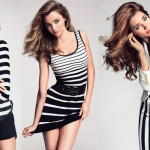Audrey Hepburn and Grace Kelly made crisp capris a go-to summer pant for everyone from chic socialites to moms on the go while Nantucket reds and Madras have reigned supreme in stylish summer enclaves across the Eastern seaboard for decades, only to make huge comebacks the past few summers in prep-inspired summer fashion collections. But where did these fancy pants get their names? We’ve tracked down the history of summer’s most classic pants and found that no matter what you call them, they’re the perfect pieces for hot days.
With a ladylike length and mass appeal, few know that the capri pant actually does draw its name from the island of Capri, known as a destination for Hollywood’s A-listers dating from film’s golden age to today. Actress/princess Grace Kelly — the original multicareer celeb — was one of the first stars to be photographed gallivanting on the island in cropped pants.
First designed in 1948 by Sonja de Lennart, the original capri pant was a sexy alternative to women’s trousers, which at the time were nearly identical to mens’ pants. De Lennart slimmed the silhouette and added a vent on the outside for comfort. She even made two specific lengths, one for summer and one for winter. As fate would have it, famed studio costumer Edith Head dressed Audrey Hepburn in “capri” pants for Roman Holiday and they made a repeat appearance in Sabrina. For that film Hubert de Givenchy himself commissioned de Lennart capris for Hepburn to wear throughout the production and she continued to wear them in subsequent films and off-camera.
Today, capri pants are popular with gamine gals who adore Audrey, and some European men. J. Crew’s café capri is a big seller throughout the year (First Lady Michelle Obama is a fan) and is available in an array of colors and patterns.
Madras comes out when the temperature goes up. While there are no scientific sartorial studies to back this up, we have only to head to East Coast summer hot spots (and look at FTD’s own Senior Writer and street style savants such as Nick Wooster) to confirm this hypothesis. It can be traced back to colonial England (along with its cousin seersucker). Madras is the old English name for the city of Chennai, in India. During colonial rule, British soldiers noticed the locals wearing brightly patterned cloth. Upon closer inspection they realized it had an extremely light weave, keeping the wearers cool.
It wasn’t until the fabric came to America though, that it gained popularity. Preppy Ivy Leaguers embraced the brightly colored fabrics. Madras pants became a country club staple and big name retailers such as Brooks Brothers, J. Press and Ralph Lauren took the fabric one step further by fashioning a patchwork version. New England preps especially loved a version made from non-colorfast fabric. It would fade and distort with each wash, lending the name bleeding madras.
Today, old menswear stalwarts still fill their racks with madras post-Memorial Day and designers such as Michael Bastian and Steven Alan show riffs on the traditional material in their spring collections on blazers, shorts and more. Even girls get in on the action — Ralph Lauren often sells madras bikinis, sundresses and shirts in his stores.
Nantucket reds have the honor of being the most self explanatory pants when it comes to their origin. Yes, they started in Nantucket with the yacht and schooner crowd and no, the Gorton’s fisherman would never wear anything this loud — his statement yellow coat says enough.
What’s not more well known is that the Nantucket red pant started at Murray’s Toggery Shop. While it’s no longer there, it was the first place to market the pants after adapting them from the New York Yacht Club uniform. Trademarked with the phrase “guaranteed to fade,” Nantucket reds started off saturated and bright and with repeat washings and a few dips in the ocean they’d lose their vibrancy and fade to a pinky salmon. Modern versions of the Nantucket red are more colorfast, so they’ll stay red and not turn pink (though these days, purveyors like J. Crew and Bonobos have artfully faded them for your convenience).
One last contender — the menswear item known as the Go to Hell pant. There’s no specific geographic location for these guys other than New England’s preppy underground scene. An oxymoron, you ask? Some credit author Tom Wolfe for coining the phrase, and it doesn’t get any more subversive than a prep who wears white year-round. He described pants fashioned from bright fabrics with everything from lobsters to whales embroidered on them — and the guys he saw wearing them would pair them with traditional staples like repp ties and navy blazers. The gall! The modern Go the Hell pant is still a rare occurrence (we haven’t seen a pair in the wild since the summer of ’10) but with Brooks Brothers pushing pink pants decorated with miniature sailboats, it won’t be long until there’s another sighting.
Photos courtesy Lands End, Brooks Brothers, tumblr, J. Crew and IMDB



















